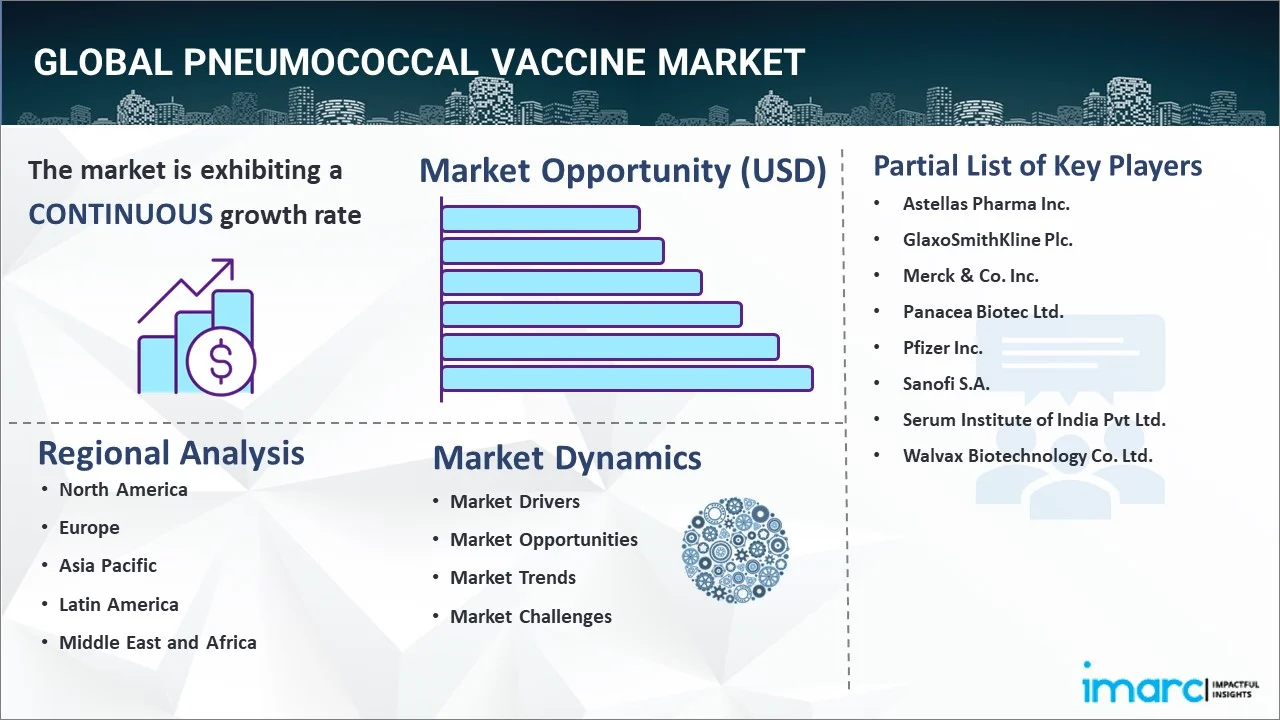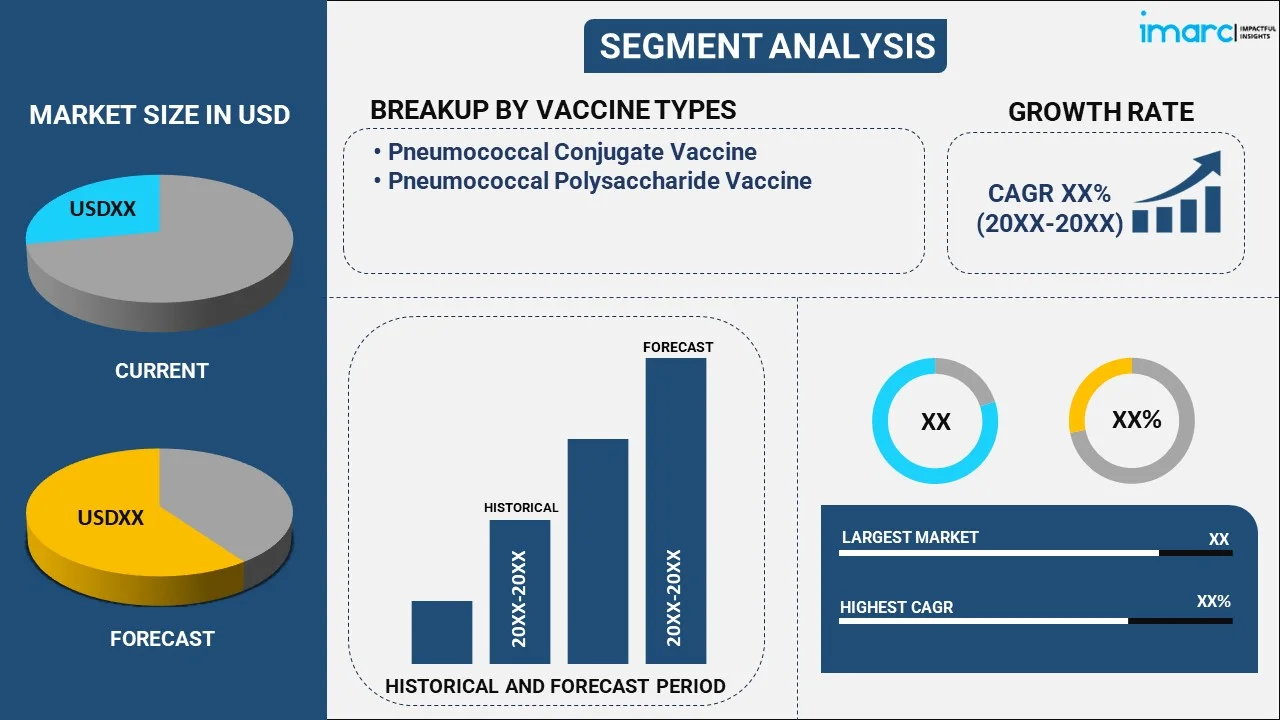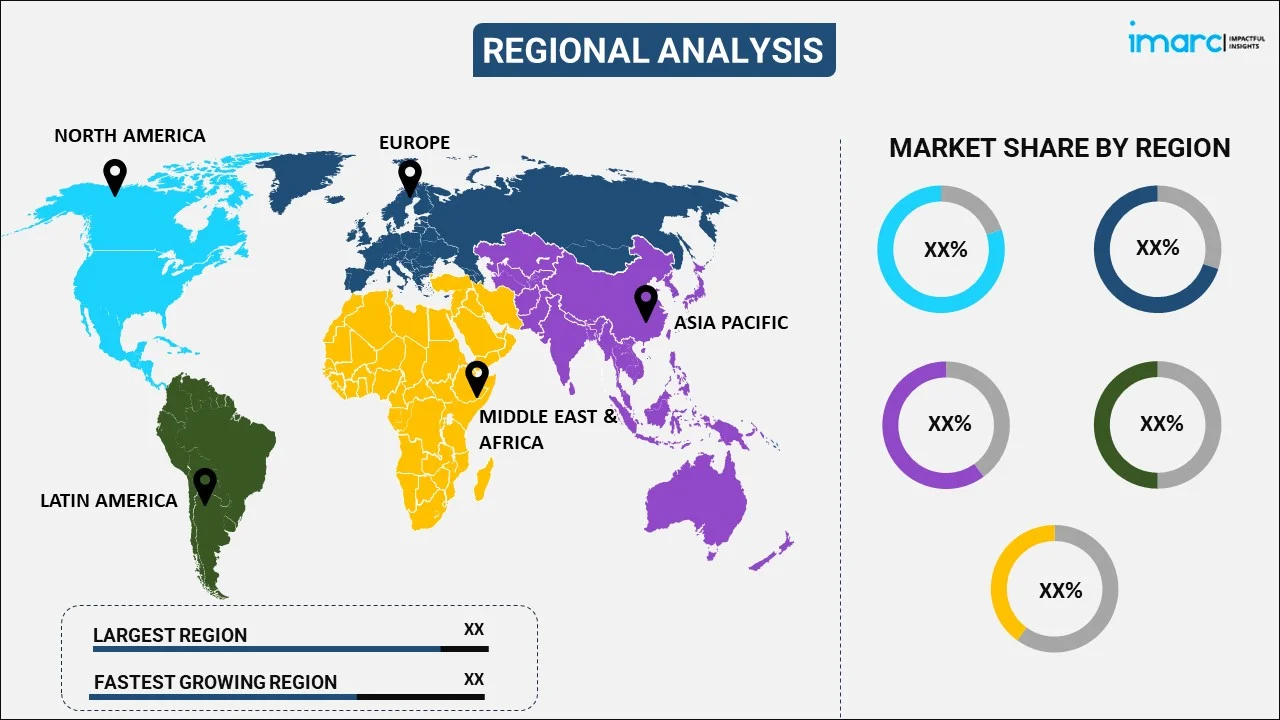
Pneumococcal Vaccine Market Report by Vaccine Type (Pneumococcal Conjugate Vaccine, Pneumococcal Polysaccharide Vaccine), Product Type (Prevnar 13, Synflorix, Pneumovax 23), Distribution Channel (Distribution Partner Companies, Non-Governmental Organizations (NGO), Government Authorities), End User (Pediatrics, Adults), and Region 2025-2033
Pneumococcal Vaccine Market Overview:
The global pneumococcal vaccine market size reached USD 9.8 Billion in 2024. Looking forward, IMARC Group expects the market to reach USD 14.9 Billion by 2033, exhibiting a growth rate (CAGR) of 4.48% during 2025-2033. The market is driven by the growing occurrence of sepsis and pneumonia diseases, rising aging population, increasing healthcare spending, governing agencies initiatives and funding, regulatory support and approvals, public health campaigns, and advancements in vaccine technology.
|
Report Attribute
|
Key Statistics
|
|---|---|
|
Base Year
|
2024
|
|
Forecast Years
|
2025-2033
|
|
Historical Years
|
2019-2024
|
|
Market Size in 2024
|
USD 9.8 Billion |
|
Market Forecast in 2033
|
USD 14.9 Billion |
| Market Growth Rate 2025-2033 | 4.48% |
Pneumococcal Vaccine Market Analysis:
- Major Market Drivers: The rise in the number of target diseases, along with governing agencies initiatives worldwide, is facilitating the market growth.
- Key Market Trends: The growing investments in research and development (R&D) activities and increasing number of pneumonia diseases are positively influencing the market.
- Geographical Trends: North America holds the largest segment because of strong healthcare infrastructure and ongoing innovations in technology.
- Competitive Landscape: Some of the major market players in the pneumococcal vaccine industry include Astellas Pharma Inc., GlaxoSmithKline Plc., Merck & Co. Inc., Panacea Biotec Ltd., Pfizer Inc., Sanofi S.A., Serum Institute of India Pvt Ltd and Walvax Biotechnology Co. Ltd., among many others.
- Challenges and Opportunities: While the market faces challenges like medical concerns associated with the vaccine, which impacts the market, it also encounters opportunities in the development and approval of novel vaccines.

Pneumococcal Vaccine Market Growth Factors:
Rising healthcare spending
High healthcare spending allows governments and private healthcare sectors to invest more in vaccination programs, leading to enhanced access and cost-effectiveness of pneumococcal vaccines, thereby increasing vaccination coverage rates across populations. In line with this, increasing healthcare spending often translates into better healthcare infrastructure, including vaccination clinics, distribution networks, and trained healthcare professionals. This infrastructure aids in the management and advocacy for pneumococcal vaccines, thus contributing to the growth of the market. Furthermore, high healthcare spending can lead to an increasing investment in research and development (R&D) activities by pharmaceutical companies, which encourages the enhancement of pneumococcal vaccines that work better, cover more serotypes or need fewer doses. According to the content updated in 2024 on the website of the Centers for Medicare & Medicaid Services, the health spending share of GDP is forecasted to grow from 17.3 percent in 2022 to 19.7 percent in 2032.
Growing aging population
Older people are more prone to pneumococcal infections, including pneumonia or invasive pneumococcal disease, due to weakened immune systems and underlying health conditions. This increasing vulnerability is leading to high utilization of pneumococcal vaccines to avoid such severe illnesses. Besides this, many governing agencies and healthcare organizations recommend pneumococcal vaccination for elderly populations as part of routine immunization schedules, which encourages healthcare providers and older adults to prioritize vaccination, thereby driving the pneumococcal vaccine demand. In addition, healthcare sectors prioritize preventive care strategies for aging populations to improve their health and minimize hospital readmissions. An article published on the website of the World Health Organization (WHO) shows that individuals aged over 60 are expected to double by 2050, reaching nearly 2.1 billion worldwide.
Increasing prevalence of sepsis
As per the content updated in 2024 on the website of the World Health Organization (WHO), almost 20 million of all estimated sepsis cases worldwide occurred in children under 5 years of age. Streptococcus pneumoniae, which causes pneumococcal infections, is one of the leading causes of sepsis, especially among children those with weakened immune systems. The rising occurrence of sepsis caused by pneumococcal infections underlines the importance of preventive approaches such as vaccination. In addition, vaccination against Streptococcus pneumoniae significantly reduces the risk of pneumococcal infections, including those that can lead to sepsis. By preventing pneumococcal diseases, vaccines help mitigate the overall burden of sepsis in healthcare settings. Apart from this, they reduce the overall burden of sepsis in care settings by preventing pneumococcal diseases. Furthermore, the administration of pneumococcal vaccines as a protective strategy against sepsis is increasing their sales. Prevention of sepsis morbidity and mortality through vaccination in public health intervention across the globe is supporting the market growth.
Pneumococcal Vaccine Market Segmentation:
IMARC Group provides an analysis of the pneumococcal vaccine industry trends in each segment, along with forecasts at the global, regional, and country levels for 2025-2033. Our report has categorized the market based on vaccine type, product type, distribution channel, and end user.
Breakup by Vaccine Type:

- Pneumococcal Conjugate Vaccine
- Pneumococcal Polysaccharide Vaccine
Pneumococcal conjugate vaccine accounts for the majority of the market share
The report has provided a detailed breakup and analysis of the market based on the vaccine type. This includes pneumococcal conjugate vaccine and pneumococcal polysaccharide vaccine. According to the report, pneumococcal conjugate vaccine represents the largest segment.
The pneumococcal conjugate vaccine (PCV) is one of the most important products in the market because of its effectiveness in improving public health particularly among children below five years and elderly people. PCVs are aimed at offering protection against various serotypes of the streptococcus pneumoniae bacterium, which is known to cause severe and sometimes fatal conditions such as pneumonia, meningitis, and sepsis. PCVs have been proven to be effective in reducing the incidence of these diseases, which makes it possible to be incorporated in national immunization programs.
Breakup by Product Type:
- Prevnar 13
- Synflorix
- Pneumovax 23
Prevnar 13 holds the largest share of the industry
A detailed breakup and analysis of the market based on the product type have also been provided in the report. This includes Prevnar 13, synflorix, and pneumovax 23. According to the report, Prevnar 13 accounts for the largest market share.
Prevnar 13 is highly preferable due to its effectiveness in preventing infections caused by Streptococcus pneumoniae bacteria. This vaccine is particularly notable for its broad coverage against thirteen different strains of the bacteria. Its incorporation in national immunization programs worldwide is greatly impacting the cases of pneumococcal diseases especially in young children and older individuals. Moreover, its well-established clinical effectiveness and safety profile are ensuring its escalated utilization throughout the world, making it an essential pillar of modern healthcare systems in combating pneumococcal diseases.
Breakup by Distribution Channel:
- Distribution Partner Companies
- Non-Governmental Organizations (NGO)
- Government Authorities
Non-governmental organizations (NGO) represent the leading market segment
The report has provided a detailed breakup and analysis of the market based on the distribution channel. This includes distribution partner companies, non-governmental organizations (NGO), and government authorities. According to the report, non-governmental organizations (NGO) represent the largest segment.
Non-governmental organizations (NGO) contribute to market dynamics through various initiatives, including funding support for vaccination programs, raising awareness about the importance of pneumococcal immunization, and collaborating with governments and pharmaceutical companies to ensure affordability and availability of vaccines. NGOs also engage in R&D activities to improve vaccine efficacy and promote vaccination campaigns aimed at vulnerable populations such as children and the elderly. Their advocacy efforts also address socio-economic disparities in healthcare access, making pneumococcal vaccines more accessible and impactful worldwide.
Breakup by End User:
- Pediatrics
- Adults
A detailed breakup and analysis of the market based on the end user have also been provided in the report. This includes pediatrics and adults.
Children, especially infants and toddlers, are highly vulnerable to pneumococcal infections, which can lead to serious illnesses, such as pneumonia, meningitis, and sepsis. Vaccination against pneumococcus bacteria is therefore recommended as part of routine childhood immunization schedules worldwide. The effectiveness of pneumococcal vaccines in preventing these infections is significantly reducing morbidity and mortality rates among children globally. Moreover, public health initiatives and immunization programs focused on pediatric populations are contributing to the pneumococcal vaccines market statistics.
As adults are aging, especially those over 65 or with underlying health conditions, they are becoming more vulnerable to pneumococcal infections, which can lead to serious illnesses, such as pneumonia, meningitis, and septicemia. Vaccination in adults helps reduce the risk of these infections and their associated complications, improving overall health outcomes and reducing healthcare costs. Additionally, adults often serve as carriers of pneumococcal bacteria, potentially spreading it to more vulnerable populations like children and the elderly people.
Breakup by Region:

- North America
- United States
- Canada
- Asia-Pacific
- China
- Japan
- India
- South Korea
- Australia
- Indonesia
- Others
- Europe
- Germany
- France
- United Kingdom
- Italy
- Spain
- Russia
- Others
- Latin America
- Brazil
- Mexico
- Others
- Middle East and Africa
North America leads the market, accounting for the largest pneumococcal vaccine market share
The report has also provided a comprehensive analysis of all the major regional markets, which include North America (the United States and Canada); Asia Pacific (China, Japan, India, South Korea, Australia, Indonesia, and others); Europe (Germany, France, the United Kingdom, Italy, Spain, Russia, and others); Latin America (Brazil, Mexico, and others); and the Middle East and Africa. According to the report, North America represents the largest regional market for pneumococcal vaccine.
As per the content updated in 2023 on the website of Centers for Medicare & Medicaid Services, U.S. health care spending grew 4.1 percent in 2022, reaching $4.5 trillion or $13,493 per person. The increasing healthcare expenditure reflects a greater emphasis on improving patient outcomes and reducing overall healthcare costs through innovative technologies. Moreover, North America has stringent regulatory frameworks and strong government support for immunization programs that contribute significantly to the growth of the market. The prevalence of pneumococcal diseases in North America, coupled with increasing awareness among healthcare professionals and the general population about the benefits of vaccination, is also driving the demand for pneumococcal vaccines.
Competitive Landscape:
- The market pneumococcal vaccine market research report has also provided a comprehensive analysis of the competitive landscape in the market. Detailed profiles of all major companies have also been provided. Some of the major market players in the pneumococcal vaccine industry include Astellas Pharma Inc., GlaxoSmithKline Plc., Merck & Co. Inc., Panacea Biotec Ltd., Pfizer Inc., Sanofi S.A., Serum Institute of India Pvt Ltd, and Walvax Biotechnology Co. Ltd.
(Please note that this is only a partial list of the key players, and the complete list is provided in the report.)
- Key players are investing in research and development (R&D) activities aimed at developing next-generation vaccine formulations. They are also expanding manufacturing capabilities to meet the growing global demand. Key players are also investing in clinical trials and studies to demonstrate efficacy and safety. They are also adopting innovative technologies for vaccine production and distribution. Many companies are implementing vaccination campaigns and educational programs to increase awareness and vaccine uptake. Key players are collaborating with other industry stakeholders, government agencies, healthcare organizations, and research institutions to expand their market reach and develop new products. For instance, in 2023, Vaxcyte, Inc. collaborated with Lonza for a new commercial manufacturing agreement. With this collaboration, Vaxcyte planned to expand its commercial manufacturing capacity for its PCV candidates.
Pneumococcal Vaccine Market Recent News:
- January 26, 2024: Pfizer Inc. received marketing authorization from the Committee of Medicinal Products designed for Human Use (CHMP) of the European Medicines Agency (EMA) for its 20-valent pneumococcal conjugate vaccine candidate (20vPnC).
- April 22, 2024: Takeda, Astellas and Sumitomo Mitsui Banking announced an agreement to establish a joint venture company for incubation of early drug discovery programs.
Pneumococcal Vaccine Market Report Scope:
| Report Features | Details |
|---|---|
| Base Year of the Analysis | 2024 |
| Historical Period | 2019-2024 |
| Forecast Period | 2025-2033 |
| Units | Billion USD |
| Scope of the Report | Exploration of Historical Trends and Pneumococcal Vaccine Market Outlook, Industry Catalysts and Challenges, Segment-Wise Historical and Future Market Assessment:
|
| Vaccine Types Covered | Pneumococcal Conjugate Vaccine, Pneumococcal Polysaccharide Vaccine |
| Product Types Covered | Prevnar 13, Synflorix, Pneumovax 23 |
| Distribution Channels Covered | Distribution Partner Companies, Non-Governmental Organizations (NGO), Government Authorities |
| End Users Covered | Pediatrics, Adults |
| Regions Covered | Asia Pacific, Europe, North America, Latin America, Middle East and Africa |
| Countries Covered | United States, Canada, Germany, France, United Kingdom, Italy, Spain, Russia, China, Japan, India, South Korea, Australia, Indonesia, Brazil, Mexico |
| Companies Covered | Astellas Pharma Inc., GlaxoSmithKline Plc., Merck & Co. Inc., Panacea Biotec Ltd., Pfizer Inc., Sanofi S.A., Serum Institute of India Pvt Ltd., Walvax Biotechnology Co. Ltd., etc. |
| Customization Scope | 10% Free Customization |
| Post-Sale Analyst Support | 10-12 Weeks |
| Delivery Format | PDF and Excel through Email (We can also provide the editable version of the report in PPT/Word format on special request) |
Key Benefits for Stakeholders:
- IMARC’s industry report offers a comprehensive quantitative analysis of various market segments, historical and current market trends, market forecasts, and dynamics of the pneumococcal vaccine market from 2019-2033.
- The research report provides the latest information on the market drivers, challenges, and opportunities in the global market.
- The study maps the leading, as well as the fastest-growing, regional markets. It further enables stakeholders to identify the key country-level markets within each region.
- Porter's five forces analysis assists stakeholders in assessing the impact of new entrants, competitive rivalry, supplier power, buyer power, and the threat of substitution. It helps stakeholders to analyze the level of competition within the pneumococcal vaccine industry and its attractiveness.
- The competitive landscape allows stakeholders to understand their competitive environment and provides insight into the current positions of key players in the market.
Key Questions Answered in This Report
The global pneumococcal vaccine market was valued at USD 9.8 Billion in 2024.
We expect the global pneumococcal vaccine market to exhibit a CAGR of 4.48% during 2025-2033.
The sudden outbreak of the COVID-19 pandemic has led to the increasing adoption of pneumococcal vaccine as an immunity booster and a preventive measure against lung injection, especially among the coronavirus-infected patients.
The rising demand for pneumococcal vaccine to help prevent lungs-, blood-, or spinal cord-related infection from spreading, reduce fatality rate, and eliminate the need for hospitalization, is primarily driving the global pneumococcal vaccine market.
Based on the vaccine type, the global pneumococcal vaccine market can be segregated into pneumococcal conjugate vaccine and pneumococcal polysaccharide vaccine. Currently, pneumococcal conjugate vaccine holds the largest market share.
Based on the product type, the global pneumococcal vaccine market has been divided into prevnar 13, synflorix, and pneumovax 23. Among these, prevnar 13 currently accounts for the majority of the total market share.
Based on the distribution channel, the global pneumococcal vaccine market can be bifurcated into distribution partner companies, Non-Governmental Organizations (NGO), and government authorities. Currently, Non-Governmental Organizations (NGO) exhibit a clear dominance in the market.
On a regional level, the market has been classified into North America, Asia-Pacific, Europe, Latin America, and Middle East and Africa, where North America currently dominates the global market.
Some of the major players in the global pneumococcal vaccine market include Astellas Pharma Inc., GlaxoSmithKline Plc., Merck & Co. Inc., Panacea Biotec Ltd., Pfizer Inc., Sanofi S.A., Serum Institute of India Pvt Ltd, and Walvax Biotechnology Co. Ltd.
Need more help?
- Speak to our experienced analysts for insights on the current market scenarios.
- Include additional segments and countries to customize the report as per your requirement.
- Gain an unparalleled competitive advantage in your domain by understanding how to utilize the report and positively impacting your operations and revenue.
- For further assistance, please connect with our analysts.
 Inquire Before Buying
Inquire Before Buying
 Speak to an Analyst
Speak to an Analyst
 Request Brochure
Request Brochure
 Request Customization
Request Customization




.webp)




.webp)












